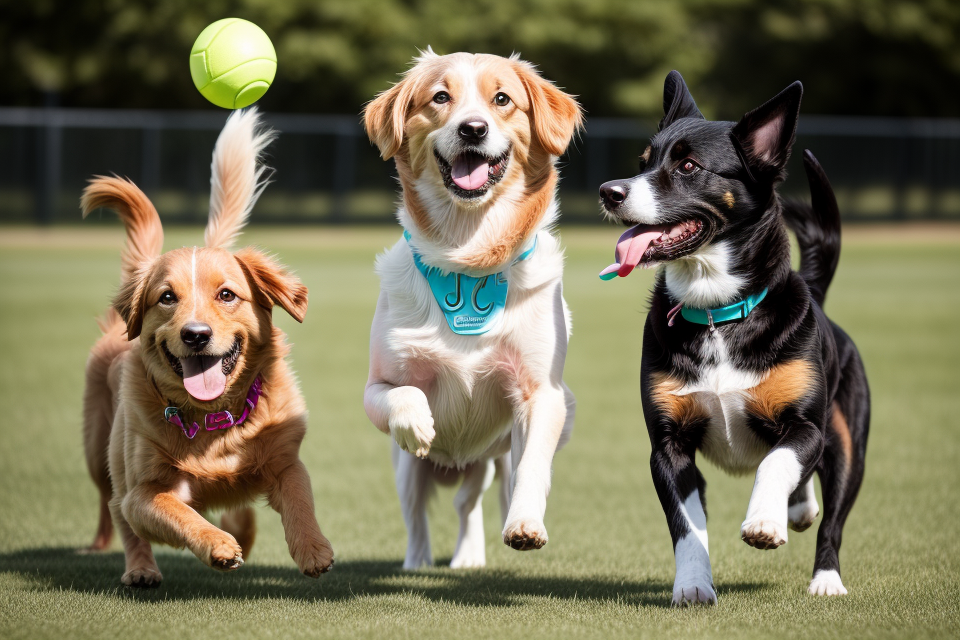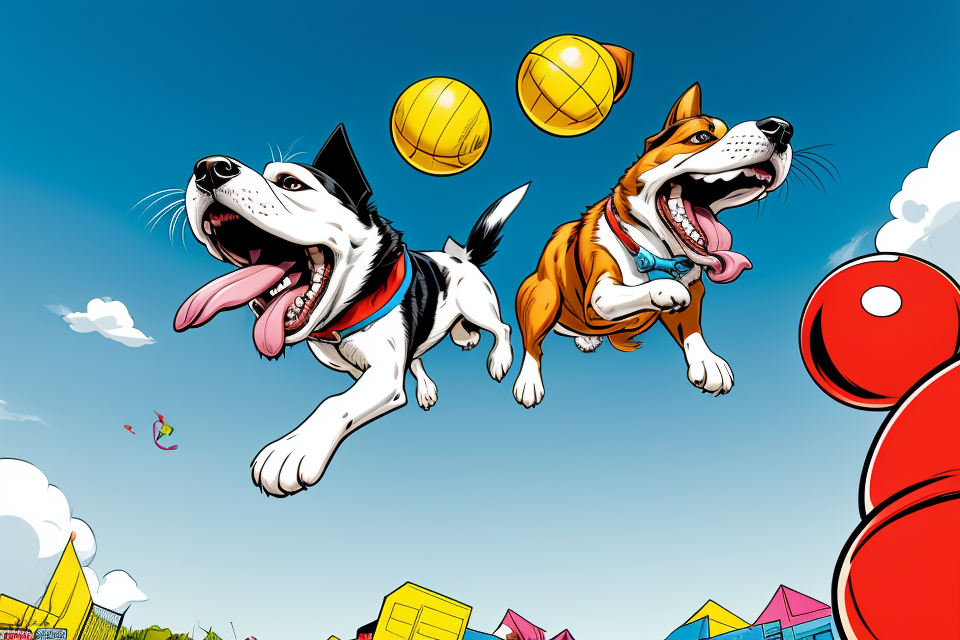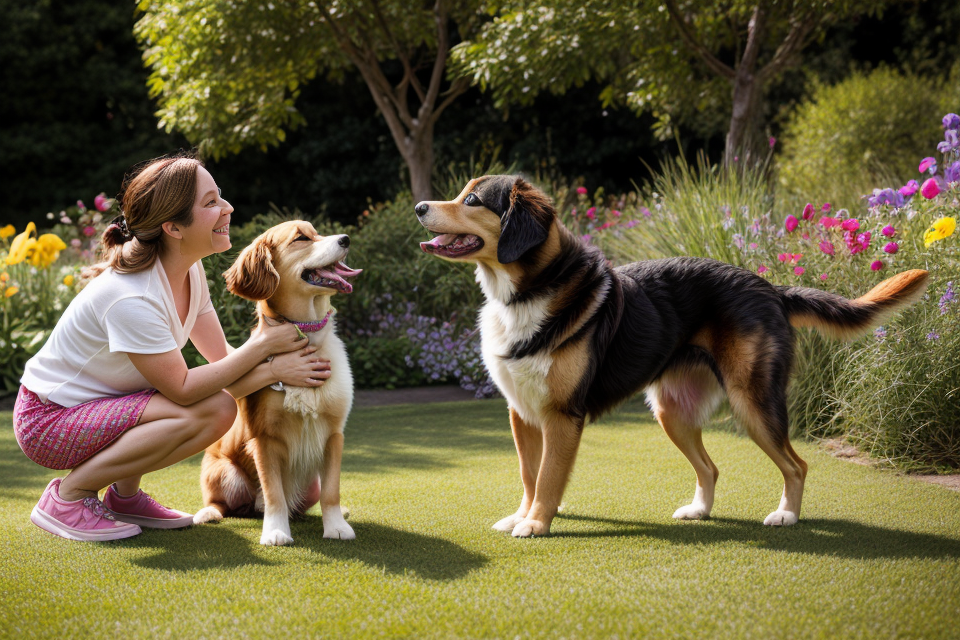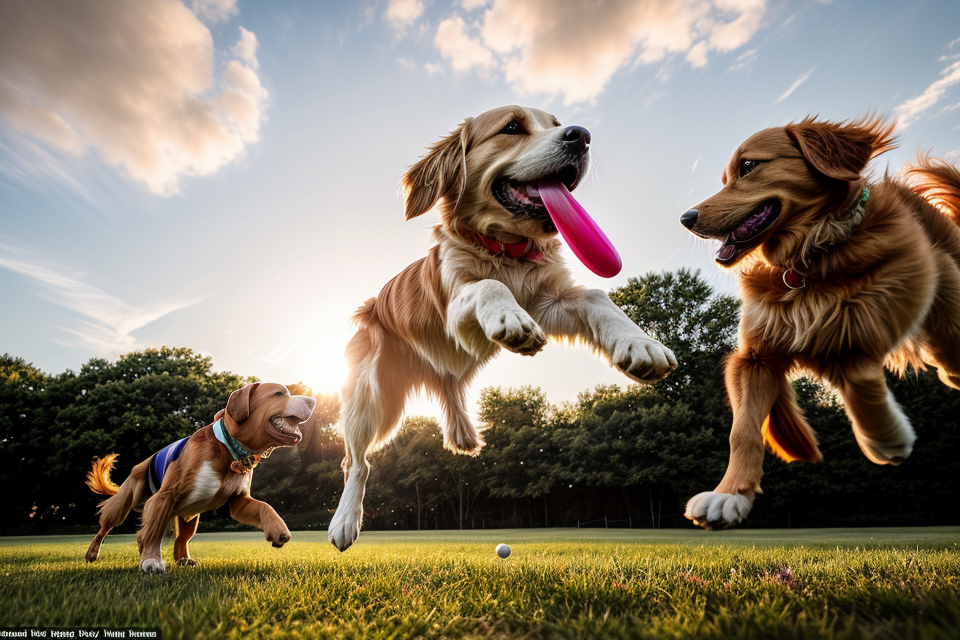Dogs are known to be man’s best friend, and it’s no secret that they are incredibly intelligent creatures. One of the best ways to keep their minds stimulated and active is through games and activities that challenge them mentally. Fetch is a classic game that many dog owners love to play with their furry friends, but is it really providing the mental stimulation that our canine companions need? In this article, we will explore the pros and cons of playing fetch with your dog and determine if it’s a good form of mental stimulation for them. So, grab your favorite fetch toy and let’s dive in!
Yes, fetch is a great mental stimulation for dogs. It provides physical exercise and mental stimulation, which is important for maintaining a healthy and happy dog. Playing fetch helps to keep dogs mentally alert and engaged, as they use their problem-solving skills to figure out how to retrieve and carry objects. It also helps to improve their hand-eye coordination and can even provide a form of stress relief. Overall, playing fetch is a fun and beneficial activity for dogs and can help to keep them happy and healthy.
The Importance of Mental Stimulation for Dogs
Benefits of Mental Stimulation
Mental stimulation is essential for dogs’ overall well-being and happiness. Providing dogs with mental stimulation can help prevent boredom, reduce stress and anxiety, and prevent unwanted behaviors such as chewing and digging. Mental stimulation can also help keep dogs mentally sharp and delay the onset of cognitive decline as they age.
Some specific benefits of mental stimulation for dogs include:
- Improved problem-solving skills: Engaging in mentally stimulating activities can help dogs develop their problem-solving skills. This can include activities such as solving puzzles, finding hidden treats, and navigating obstacle courses.
- Increased socialization: Mental stimulation can also help dogs improve their socialization skills. This can be especially beneficial for dogs who are shy or anxious around other dogs or people.
- Reduced stress and anxiety: Mental stimulation can help dogs burn off excess energy and reduce stress and anxiety. This can be especially helpful for dogs who are prone to separation anxiety or who get overly excited during playtime.
- Better physical health: Mental stimulation can also have physical benefits for dogs. For example, puzzle toys that require dogs to use their mouths and paws can help prevent dental problems and keep nails trimmed.
Overall, providing dogs with mental stimulation is important for their overall well-being and happiness. Engaging in mentally stimulating activities can help prevent boredom, reduce stress and anxiety, and keep dogs mentally and physically fit.
Types of Mental Stimulation
Dogs, like humans, require mental stimulation to stay healthy and happy. Engaging their minds can prevent boredom, reduce stress, and prevent destructive behaviors. There are several types of mental stimulation that can benefit dogs.
Interactive Play
Interactive play involves engaging with your dog using toys, treats, and other objects. This type of mental stimulation can help strengthen the bond between you and your dog, as well as improve their problem-solving skills.
Scent Work
Scent work involves using your dog’s sense of smell to search for hidden objects or scents. This type of mental stimulation can be a fun and challenging activity for dogs, and can help improve their focus and concentration.
Obstacle Courses
Obstacle courses can be set up in your home or yard, and can include various challenges such as tunnels, ramps, and obstacles to navigate. This type of mental stimulation can help improve your dog’s physical and mental agility, as well as their problem-solving skills.
Food Puzzles
Food puzzles involve hiding treats or meals in toys or puzzles for your dog to figure out. This type of mental stimulation can help improve your dog’s problem-solving skills, as well as provide them with mental stimulation while they work to figure out how to access their food.
Training
Training is another important type of mental stimulation for dogs. Training can help improve your dog’s obedience, as well as provide them with mental stimulation and structure. It can also help strengthen the bond between you and your dog.
Overall, providing your dog with a variety of mental stimulation activities can help keep them healthy, happy, and engaged.
Fetch as a Form of Mental Stimulation
Overview of Fetch
Fetch is a popular game played by humans and their canine companions. The objective of the game is to retrieve an object thrown by the human and bring it back. The game requires the dog to use its sense of smell and sight to locate the object and its sense of touch to pick it up. Fetch can be played with a variety of objects, including balls, frisbees, and toys.
One of the main benefits of fetch as a form of mental stimulation for dogs is that it provides them with physical exercise. Running after a thrown object can help keep dogs fit and healthy, both mentally and physically. In addition to physical exercise, fetch also provides dogs with mental stimulation by encouraging them to use their problem-solving skills and enhance their cognitive abilities.
Another benefit of fetch is that it strengthens the bond between the dog and its human companion. Playing fetch together creates a sense of trust and companionship between the dog and its owner, which can lead to a stronger and more meaningful relationship.
Overall, fetch is a fun and engaging game that provides dogs with both physical and mental stimulation. It is a great way to keep dogs active and healthy while also strengthening the bond between the dog and its human companion.
How Fetch Provides Mental Stimulation
Fetch is a game that involves retrieving an object and is widely considered as a form of mental stimulation for dogs. It is believed that playing fetch can provide various cognitive benefits for dogs, such as improving their problem-solving skills, increasing their memory and attention span, and enhancing their ability to learn new commands.
One way fetch provides mental stimulation is by engaging a dog’s natural instinct to chase and retrieve. When a dog picks up an object, they have to use their sense of smell and vision to locate the item and their sense of touch to manipulate it. This process requires the dog to use their problem-solving skills and encourages them to think creatively and strategically.
Fetch also helps to improve a dog’s memory and attention span. When a dog is playing fetch, they have to remember where they left the object and how they can retrieve it. This requires them to focus and pay attention to their surroundings, which can help to improve their memory and attention span over time.
In addition, fetch can be used as a tool to teach dogs new commands and enhance their ability to learn. When a dog is playing fetch, they are motivated to listen to their owner’s instructions and follow through with the desired action. This can help to strengthen the bond between the dog and owner and make training sessions more effective.
Overall, fetch is a fun and engaging game that can provide numerous cognitive benefits for dogs. By incorporating fetch into their daily routine, dog owners can help to keep their pets mentally stimulated and happy.
Different Types of Fetch Toys
When it comes to fetch toys for dogs, there are several options available in the market. These toys are designed to provide mental stimulation for dogs by engaging their natural instincts to chase, retrieve, and chew. Here are some of the different types of fetch toys that can be used for mental stimulation:
- Flat Fetch Toys: These toys are designed to fly through the air and are ideal for dogs that love to chase and catch objects in mid-air. Examples include frisbees, flyers, and discs.
- Floating Fetch Toys: These toys are designed to float on water and are ideal for dogs that love to play in the water. Examples include balls, plush toys, and flying discs.
- Tug Fetch Toys: These toys are designed for dogs that love to play tug-of-war. Examples include ropes, tug toys, and rings.
- Treat Dispensing Fetch Toys: These toys are designed to dispense treats as dogs play with them. Examples include puzzle toys, interactive games, and treat-dispensing balls.
- Plush Fetch Toys: These toys are designed to be soft and cuddly, making them ideal for dogs that love to carry and cuddle with their toys. Examples include stuffed animals, plush balls, and soft plush toys.
- Squeaky Fetch Toys: These toys are designed to make noise when dogs chew or play with them, providing auditory stimulation in addition to mental stimulation. Examples include squeaky toys, stuffed animals, and balls.
- Interactive Fetch Toys: These toys are designed to provide interactive play between dogs and their owners. Examples include tug toys, fetch toys with hidden compartments, and interactive puzzle toys.
In summary, there are many different types of fetch toys available that can provide mental stimulation for dogs. The key is to choose toys that match your dog’s interests and abilities, and to rotate toys regularly to keep playtime interesting and engaging.
Other Forms of Mental Stimulation for Dogs
Interactive Games
Dogs are intelligent creatures that thrive on mental stimulation. While fetch is a popular game that provides dogs with exercise and mental stimulation, there are other interactive games that can be just as effective. These games engage dogs in problem-solving, decision-making, and cognitive challenges, providing them with the mental stimulation they need to stay happy and healthy. Here are some examples of interactive games that dog owners can try:
Hide and Seek
Hide and seek is a classic game that provides dogs with mental stimulation by encouraging them to use their sense of smell and memory to find hidden objects. To play, owners can hide treats or toys around the house or yard and have their dogs search for them. This game is especially beneficial for dogs that struggle with separation anxiety or destructive behaviors, as it keeps their minds active and engaged.
Treiball
Treiball is a game that involves a dog chasing a ball that is moved by a handler. The game is designed to improve a dog’s agility, coordination, and focus, and it provides mental stimulation by requiring the dog to think about where the ball is going and how to get there. Treiball is especially helpful for high-energy dogs that need more mental stimulation to stay focused and calm.
Scent Work
Scent work is a game that involves a dog using its sense of smell to find hidden objects. This game is especially beneficial for dogs that are trained in search and rescue, as it helps them to develop their scenting abilities and improves their focus and attention. Scent work can be done in a variety of settings, including in the yard or park, and it provides dogs with mental stimulation and exercise.
Puzzle Toys
Puzzle toys are another form of interactive games that provide dogs with mental stimulation. These toys are designed to challenge dogs to figure out how to get a treat or toy out of a container or box. Some puzzle toys require dogs to use their paws or nose to push or pull a lever, while others require them to figure out how to flip or spin a mechanism to get the treat. Puzzle toys are especially helpful for dogs that need mental stimulation when they are indoors or when their owners are away from home.
In conclusion, there are many other forms of interactive games that can provide dogs with mental stimulation, beyond just fetch. From hide and seek to scent work, puzzle toys to Treiball, there are a variety of activities that dog owners can try to keep their pets mentally stimulated and engaged.
Puzzle Toys
Puzzle toys are an excellent form of mental stimulation for dogs, providing them with challenges that require problem-solving skills and cognitive abilities. These toys come in various forms and designs, each with its unique features and benefits. Some of the most popular puzzle toys for dogs include:
Interactive Puzzle Toys
Interactive puzzle toys are designed to provide dogs with a challenge by requiring them to figure out how to access a hidden treat or toy. These toys often involve sliding, pushing, or rotating different parts to reveal the reward. Examples of interactive puzzle toys include the “Nina Ottosson” games, which feature various obstacles that dogs must navigate to reach the reward, and the “Outward Hound” puzzle toys, which challenge dogs to move a piece to a specific location to reveal the treat.
Hide-and-Seek Toys
Hide-and-seek toys are designed to encourage dogs to use their sense of smell and instinct to find hidden treats or toys. These toys often involve hiding treats in different compartments or chambers, and dogs must use their noses to sniff out the location of the reward. Examples of hide-and-seek toys include the “Kong Snuffle Mat” and the “Planet Dog Orbee-Treat Dispenser.”
Food Puzzles
Food puzzles are designed to slow down a dog’s eating pace and encourage mental stimulation by requiring them to figure out how to access the food. These toys often involve moving or manipulating different parts to reveal the food, such as the “Flavorit” or the “Chewster.”
Scent Work Toys
Scent work toys are designed to engage a dog’s sense of smell and encourage them to use their natural instincts to find hidden treats or toys. These toys often involve hiding treats or toys in specific locations and requiring dogs to use their noses to find them. Examples of scent work toys include the “Nose Work Kit” and the “Sniffing Out a Cure” game.
In conclusion, puzzle toys are an excellent form of mental stimulation for dogs, providing them with challenges that require problem-solving skills and cognitive abilities. With so many different types of puzzle toys available, dog owners can choose the ones that best suit their dog’s interests and abilities.
Training and Learning Activities
Obstacle Courses
Obstacle courses can be a great way to challenge your dog mentally and physically. They can be designed to suit different levels of difficulty, depending on your dog’s age, size, and breed. These courses can include tunnels, ramps, weave poles, jumps, and other obstacles that require your dog to think and problem-solve.
Scent work is a fun and challenging activity that involves teaching your dog to identify and locate specific scents. This can include searching for hidden objects, identifying scents in containers, or even finding a missing person. Scent work is a great way to challenge your dog’s mind and improve their problem-solving skills.
Puzzle toys are a great way to provide mental stimulation for your dog. These toys can be filled with treats or peanut butter and require your dog to figure out how to get the reward. There are many different types of puzzle toys available, including ones that require your dog to push, pull, or turn objects to get the reward.
Trick Training
Trick training is a fun and rewarding activity that can help improve your dog’s obedience, cognitive abilities, and overall well-being. Tricks can range from simple commands like “sit” and “stay” to more complex behaviors like “shake” and “high five.” Trick training is a great way to bond with your dog and provide them with mental stimulation.
Interactive Games
Interactive games are a great way to provide mental stimulation for your dog. These games can include activities like hide and seek, find it, and scent work. They can also include interactive toys that require your dog to use their problem-solving skills to get a reward. Interactive games are a great way to keep your dog mentally stimulated and engaged.
Considerations for Choosing Mental Stimulation Activities
Dog’s Age and Ability
When choosing mental stimulation activities for your dog, it is important to consider their age and ability level. Different activities may be more appropriate or enjoyable for dogs at different stages of life. Here are some factors to consider:
- Puppies: Puppies are often eager to learn and play, and mental stimulation activities can help them develop important skills such as problem-solving and memory. Simple activities such as hiding treats for them to find or teaching them basic obedience commands can be a great way to stimulate their minds.
- Adult Dogs: Adult dogs may enjoy more complex mental stimulation activities such as scent work, agility, or obedience trials. These activities can challenge their problem-solving abilities and keep them mentally stimulated. It is important to choose activities that are appropriate for their skill level and interests.
- Senior Dogs: Senior dogs may have different physical limitations, but they can still benefit from mental stimulation activities. Activities such as interactive toys, puzzle games, or even just spending quality time with their owners can help keep their minds active and prevent boredom. It is important to adjust the level of activity based on their physical abilities and energy levels.
In general, it is important to choose mental stimulation activities that are appropriate for your dog’s age and ability level. This will help ensure that they are having fun and staying mentally stimulated, while also avoiding activities that may be too challenging or overwhelming for them.
Size and Strength of the Dog
When selecting a mental stimulation activity for a dog, it is important to consider the dog’s size and strength. Larger dogs may require more physical and mental stimulation to prevent boredom and destructive behavior. They may also require more challenging activities to keep them engaged. On the other hand, smaller dogs may be satisfied with simpler activities and may become overwhelmed by too much stimulation.
Additionally, a dog’s strength should also be taken into consideration. Some dogs, regardless of size, may have high levels of energy and strength, which may require the owner to provide more challenging activities to prevent the dog from becoming bored or destructive.
It is important to select activities that are appropriate for the dog’s size and strength, as well as their individual preferences and needs. Providing activities that are too easy or too challenging can lead to boredom or frustration, which can negatively impact the dog’s behavior and well-being.
Availability of Resources
When considering mental stimulation activities for dogs, it is important to take into account the availability of resources. This includes not only the physical resources required for the activity, such as toys or equipment, but also the time and energy required to participate in the activity.
For example, fetch may be a great mental stimulation activity for dogs that have access to a large, secure outdoor space where they can run and play with a ball or other toy. However, for dogs that live in apartments or small homes, fetch may not be a practical activity due to limited space and the potential for damage to furniture or other items in the home.
Additionally, some dogs may require more mental stimulation than others due to breed, age, or individual personality. For example, working breeds such as German Shepherds and Golden Retrievers have a high need for mental stimulation and may become bored or restless without adequate mental exercise. On the other hand, senior dogs or those with mobility issues may require more low-impact activities that do not require as much physical exertion.
Overall, it is important to consider the availability of resources when choosing mental stimulation activities for dogs, as well as the individual needs and abilities of the dog. By taking these factors into account, dog owners can ensure that their pets are engaged and stimulated, both physically and mentally.
Final Thoughts on Fetch as a Mental Stimulation Activity for Dogs
While fetch can be a fun and engaging activity for dogs, it is important to consider the individual needs and preferences of each dog. Some dogs may enjoy fetch and find it mentally stimulating, while others may become bored or stressed by the activity.
It is also important to consider the physical health and abilities of the dog. Dogs with joint or mobility issues may not be able to participate in fetch, or may require modifications to the activity to ensure their comfort and safety.
In addition, it is important to supervise dogs during any activity, including fetch, to ensure their safety and prevent any accidents or injuries.
Overall, while fetch can be a fun and mentally stimulating activity for some dogs, it is important to consider the individual needs and preferences of each dog and to prioritize their safety and well-being.
FAQs
1. What is fetch and how does it benefit dogs?
Fetch is a game in which a dog retrieves an object thrown by its owner. It is a great way to provide mental stimulation for dogs as it requires them to use their problem-solving skills, memory, and nose work. Fetch helps keep dogs mentally and physically active, and it strengthens the bond between the dog and the owner.
2. How often should I play fetch with my dog?
You should play fetch with your dog as often as possible, preferably every day. However, the frequency of play depends on your dog’s age, breed, and physical condition. For example, older dogs or those with joint problems may need to play fetch less frequently. It’s important to monitor your dog’s energy levels and adjust the frequency and duration of play accordingly.
3. What type of objects should I use for fetch?
You can use a variety of objects for fetch, such as balls, frisbees, and toys. The object should be small enough for your dog to pick up and carry in its mouth, but not so small that it can be swallowed. You can also experiment with different textures and materials to keep the game interesting for your dog.
4. How far should I throw the object during fetch?
The distance you throw the object depends on your dog’s physical abilities and the size of the playing area. For smaller dogs or older dogs, you may want to start with shorter distances and gradually increase the distance as your dog becomes more confident and physically able. It’s important to keep the game fun and avoid frustration for your dog.
5. Can fetch be played indoors or only outdoors?
Fetch can be played both indoors and outdoors, depending on your preference and your dog’s needs. Indoor fetch can be played in a large open space or in a fenced area. Outdoor fetch can be played in a park or a backyard. It’s important to make sure the playing area is safe and free of hazards, and to supervise your dog at all times.
6. Can other activities provide the same mental stimulation as fetch?
Yes, there are other activities that can provide similar mental stimulation as fetch, such as scent work, agility, and puzzle toys. These activities require your dog to use its problem-solving skills, memory, and nose work, and they provide mental stimulation and physical exercise. It’s important to mix up the activities to keep them interesting and engaging for your dog.



